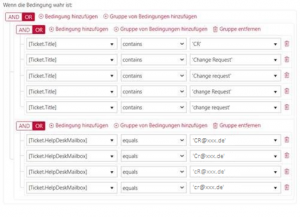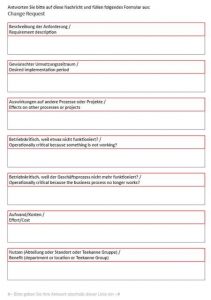For a ticketing system to send ready-made standard responses to new requests is… well… standard. In addition, depending on the request, a form to be filled out can be automatically sent to the requester(s).
Let’s look at the following example scenario:
Incoming mails in a helpdesk should be sorted from the start according to (potentially chargeable) change requests and support requests included in the service.
This can be implemented rule-based in such a way that a corresponding key term is already searched for in the subject of the mail and the ticket is classified in the respective category.
For example, if the helpdesk receives an email with the term “Change Request” (or the abbreviation CR) in the subject line, the system uses this key term to set the category of the newly created ticket to “Change Request” and sends a form to be filled out as a reply .
Alternatively, a separate email address can be set up for change requests, eg cr@XXX.de . Customers could then consciously send a corresponding request to this email address, and it would be created as a ticket in the “Change Request” category. The appropriate form would be sent as the first response.
Customers would send “normal” support requests to a different email address, eg support@XXX.de.
As can be seen in the screenshot, the rule checks whether there is a specific text in the subject line or whether the mail was sent to a specific email address:
If it is recognized that it is a change request, the category of the new ticket to be created is set to the value “Change Request” and the reporter receives an email reply with a note and a form to fill out:
Of course there can also be the situation that a supposedly “normal” ticket is only recognized as a change request by the ticket processor. He then changes the category of the ticket in the backend to the appropriate value. In this case, the template for the ready-made response is linked to a file that is sent to the reporter as an attachment as soon as the ticket is saved.
Other application scenarios are also conceivable:
- A university institute manages the inquiries of the students accordingly, so that, for example, it is recognized based on rules whether an incoming mail is an application for a reading card for the institute library, a password change for access to protected areas of the website or a request for an appointment for the office hours Institute management acts. Depending on the category, a suitable form can be sent with the reply email.
- A doctor’s office can relieve its switchboard and allow patient contacts via e-mail. When a new patient requests an appointment for the first time, the anamnesis form to be filled out is sent directly with the reply email.
Can you imagine that there are also possible applications for you?
Contact us, we are happy to help with the implementation!

